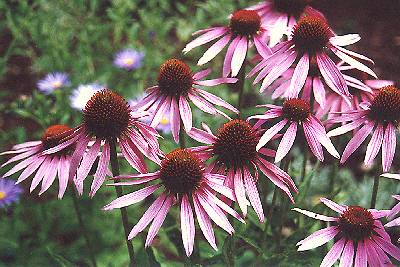Echinacea purpurea
PURPLE CONEFLOWER
Family: Asteraceae
Pronounced: ek-in-AY-see-ah pur-PEWR-ree-ah
Quick Jumps
Growing Guide
Rainy Side Notes
GROWING GUIDE

Origin:
North America.
Plant Group:
Perennial herb.
Hardiness:
Sunset zones: A2, A3; 1-24.
USDA zones: 3-9.
Heat zones: 9-1.
Mature size:
Height: 2-3 feet (60-90cm).
Width: 18 inches (45 cm).
Flowering period:
Midsummer to early autumn.
Flowering attributes:
Brown disks surrounded by purple-red reflexed petals.
Leaf attributes:
Hairy, ovate basal 6-inch leaves.
Growth habit:
Clump-forming.
Light:
Full sun.
Soil:
Humus rich, well-drained soil.
Feeding:
Side dress with compost or manure. Fertilize in spring with a complete organic fertilizer.
Propagation Methods:
Sow seed at 68°F (20°C) in spring.
Divide in autumn of spring.
Pruning Methods:
Dead head flowers for longer bloom period.
Pests and Diseases:
Leaf miners and occassionally powdery mildew and fungal leaf spots are a problem.
Rainy Side Notes
Echinacea comes from the Greek word echinos that refers to the prickly receptacle scales; purpurea means purple flower.
My first echinacea I grew years ago was one of my favorites in the herb garden. With many new hybrids in the coneflower clan, this tends to take a back seat to the cultivars.
Deer resistant, Echinaceas are great butterfly, bird and bee plants. Leaving the seed heads in place will bring in flocks of goldfinches, who devour the seeds over winter.
For fresh flowers, it is best to harvest when petals are expanding. Flowers last 7-10 days in a vase when a preservative is used. When harvesting only for the orange disk, allow the petals to mature before harvesting so the petals will be easy to remove. For drying purposes, remove petals and hang to dry.
Photographed in author's garden.

Gardening for the Homebrewer: Grow and Process Plants for Making Beer, Wine, Gruit, Cider, Perry, and More
By co-authors Debbie Teashon (Rainy Side Gardeners) and Wendy Tweton
Copyright Notice | Home | Search | Perennials

